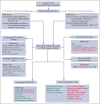How I approach bleeding in hospitalized patients
- PMID: 36652635
- PMCID: PMC10562531
- DOI: 10.1182/blood.2021014766
How I approach bleeding in hospitalized patients
Abstract
Excessive bleeding is relatively common in adult inpatients, whether as the primary reason for admission or as a development during the hospital stay. Common causes include structural issues, medication effects, and systemic illnesses; occasionally, unexpected bleeding can develop as a result of an undiagnosed or newly acquired bleeding disorder. The first step in caring for the inpatient who is bleeding is to determine whether the bleeding symptom is truly new or whether the patient has a history of abnormal bleeding. Patients with a history of abnormal bleeding may warrant evaluation for inherited bleeding disorders, such as platelet function disorders, von Willebrand disease, hemophilia, or rare factor deficiencies. Patients with no history of bleeding, for whom other causes, such as liver dysfunction, medication effect, disseminated intravascular coagulation, or certain vitamin deficiencies have been ruled out may require evaluation for acquired coagulopathies, such as acquired hemophilia or acquired von Willebrand disease. Here, we present 3 cases to discuss the diagnosis and management of the 2 most common acquired bleeding disorders as well as a patient with a congenital bleeding disorder with a historical diagnosis.
© 2023 by The American Society of Hematology. Licensed under Creative Commons Attribution-NonCommercial-NoDerivatives 4.0 International (CC BY-NC-ND 4.0), permitting only noncommercial, nonderivative use with attribution. All other rights reserved.
Conflict of interest statement
Conflict-of-interest disclosure: B.A.K. has received research funding from CSL Behring, Genentech, Pfizer, Sanofi, and Takeda and has served as a paid consultant for Octapharma, Pfizer, and Sanofi. B.S.B. declares no competing financial interests.
Figures


References
-
- Kirtava A, Crudder S, Dilley A, Lally C, Evatt B. Trends in clinical management of women with von Willebrand disease: a survey of 75 women enrolled in haemophilia treatment centres in the United States. Haemophilia. 2004;10(2):158–161. - PubMed
-
- Kadir RA, Sharief LA, Lee CA. Inherited bleeding disorders in older women. Maturitas. 2012;72(1):35–41. - PubMed
-
- American College of Obstetricians and Gynecologists' Committee on Practice Bulletins—Obstetrics 196: Thromboembolism in pregnancy. Obstet Gynecol. 2018;132(1):e1–e17. - PubMed
-
- Hsieh L, Nugent D. Factor XIII deficiency. Haemophilia. 2008;14(6):1190–1200. - PubMed
-
- Pelcovits A, Schiffman F, Niroula R. Factor XIII deficiency: a review of clinical presentation and management. Hematol Oncol Clin North Am. 2021;35(6):1171–1180. - PubMed
Publication types
MeSH terms
Grants and funding
LinkOut - more resources
Full Text Sources
Medical

